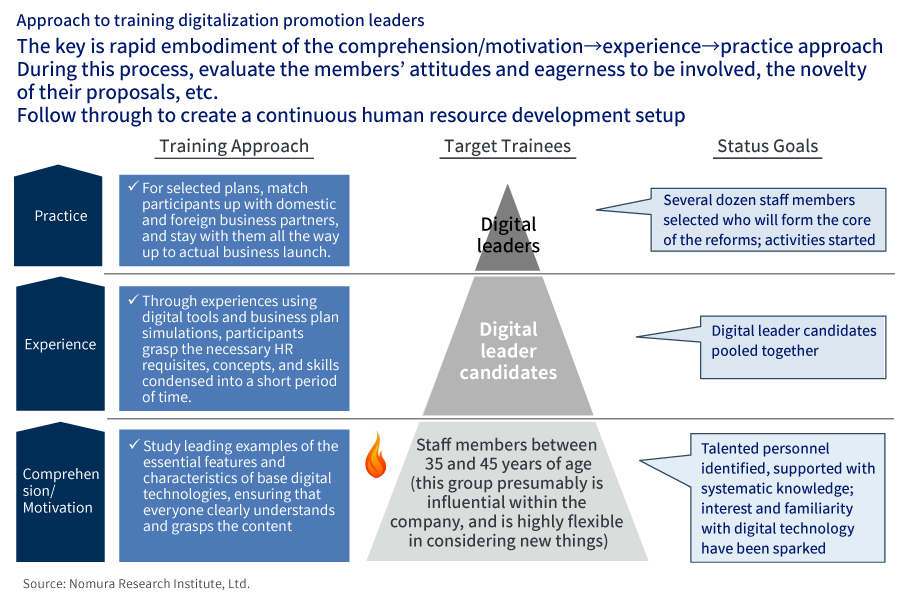
Training Digitalization Promotion Leaders -- Creating Companies with High Digital Literacy
Although digital transformation (DX) has gained attention in recent years, at most companies, DX is left to specific divisions such as the IT division or the digital promotion office, while those in other divisions consider it to have nothing to do with them. However, NRI’s Takashi Nakazawa believes that for DX to succeed, it is important for every individual in the company—from the top management down to the ground-floor operators in the business divisions—to improve their digital literacy, and to be able to actively apply and utilize digital technology in their operations. We sat down with Nakazawa, who has spent many years in IT management consulting, and asked him to share his views on the subject.
Digitally savvy human resources are lacking, both qualitatively and quantitatively
--- What are the problems that many companies face when promoting DX?
I’ve heard many companies express concerns over their lack of digitally savvy human resources. This phenomenon was also conspicuously apparent in the results of the “Survey on the Actual Use of IT” questionnaire conducted by NRI. But on an individual level, I think that even more so than the digital aspect, the qualitative and quantitative lack of IT human resources is a major problem. At the outset of the 2000s, the introduction of things like ERP (enterprise resource planning systems) led Japanese companies to actively engage in IT investments, but then not enough such investments have been made subsequently. IT human resources work has come to be centered on the maintenance and operation of large-scale systems, and human resources with capabilities in project management or system requirement definitions haven’t really been cultivated.
In this regard, the Ministry of Economy, Trade and Industry (METI) has sounded the alarm about what it calls the “2025 Digital Cliff”. This has to do with the fear that more and more companies will be falling into predicaments where their systems can’t handle things when some kind of trouble occurs, or where they want to refurbish the old systems but they don’t have people who understand the core of their operations or the logic involved. And I think with IT organizations being debilitated in this way, the fact is that companies can’t really adapt themselves to AI (artificial intelligence) or DX even if they’re told about these technologies.
Digitalization requires a certain resolve from top management
--- With such steady progress being made in the IT field, why have IT-related investments fallen behind the curve?
There’s a tendency among companies where, after they’ve rolled out their basic systems and their existing business is going well, the managers or executive-level people who’ll be retiring in a few years are reluctant to make new investments, because they wonder if it’s really necessary at the current time to put effort into digitalization. Plus, even if companies are pursuing DX, they tend to delegate all of the decision-making to their IT divisions or digital technology divisions. In the meanwhile, the top management really needed to deepen its understanding of digitalization as well. If a company doesn’t make bringing digitally savvy human resources into the fold and mastering digital technologies part of its competitive strength, then it can’t be said to be involved in digital transformation.
In terms of management resolve, there aren’t that many companies that have decided to pursue fully-fledged digitalization and are paving the way. Looking at NRI’s “Survey on the Actual Use of IT”, we see that only about 5% of companies have appointed a CDO (chief digital officer) or other type of dedicated digital technology officer, and even in cases where these executives occupy another position concurrently, this number is only around 10%. In order to adopt the mentality that using digital technology regularly will make work easier, companies need to enhance the digital literacy of their human resources on the operation side, and to add more digitalization promoters to their ranks.
Enhancing literacy through “comprehension/motivation”, “experience”, and “practice”
--- What kinds of efforts can be made to enhance digital literacy?
What we do together with our client companies is to focus on personnel between 35 and 45 years of age who will be running company operations in the future, and we apply a three-stage approach: “comprehension/motivation”, where we raise their level of sensitivity to using digital technology; “experience”, where we have them actually try out digital tech; and “practice”, where they learn by trial and error so that they can apply the technology to their own businesses.
With the first part, “comprehension/motivation”, we focus on a classroom lecture-type program, and have the participants learn about the impact that digitalization is having on the world, and have them pay attention to the need for internal company changes using digital technology. Next, there’s our “Advanced Technology Experience Workshop” (DiMiX), where we prepare various cutting-edge digital tools like VR (virtual reality) glasses and AI programs, and have them actually try these out. This isn’t just a matter of learning about technology as knowledge. By having them personally use the technologies to get a real sense of what’s convenient or inconvenient about them, we enable them to think more concretely about how to apply digital technology to everyday operations or make proposals to customers.
After that, we don’t just end it by having the participants tell us what an interesting experience it was. We have them think about the kinds of situations or operations in which these digital tools can be used in order to connect what they learned to practical implementation. Instead of conducting our sessions in digital labs or other kinds of special hands-on venues, we do it by bringing our tools to the customer’s location, and so they can try things out on-site. It’s ideal when this leads people to have new ideas or to run technical trials.

Determining how digitalization is connected to your company’s ability to provide value
--- Lastly, please share any advice you have for companies that are dealing with problems involving IT personnel or digital personnel.
Using cars as an example, if you think what your company provides is cars as “hardware”, then you need engineers for that purpose. But if you think your company provides value as MaaS (Mobility as a Service), a mobility-related service that includes cars, then the software constituting your service will be even more important than ever for creating that value. And if you believe that IT or digital technology is essential for your company to create value, you need to make some kind of investment, whether that be recruiting capable personnel from outside, training them internally, or working hand-in-hand with partners who have the capabilities. If you’re going to be training staff, it’ll take between five and ten years, so I think it’s important to thoroughly consider right now, at this moment, whether your traditional way of doing things will suffice for providing value going forward, or whether you need to make some changes.

Profile
-
Takashi Nakazawa
* Organization names and job titles may differ from the current version.